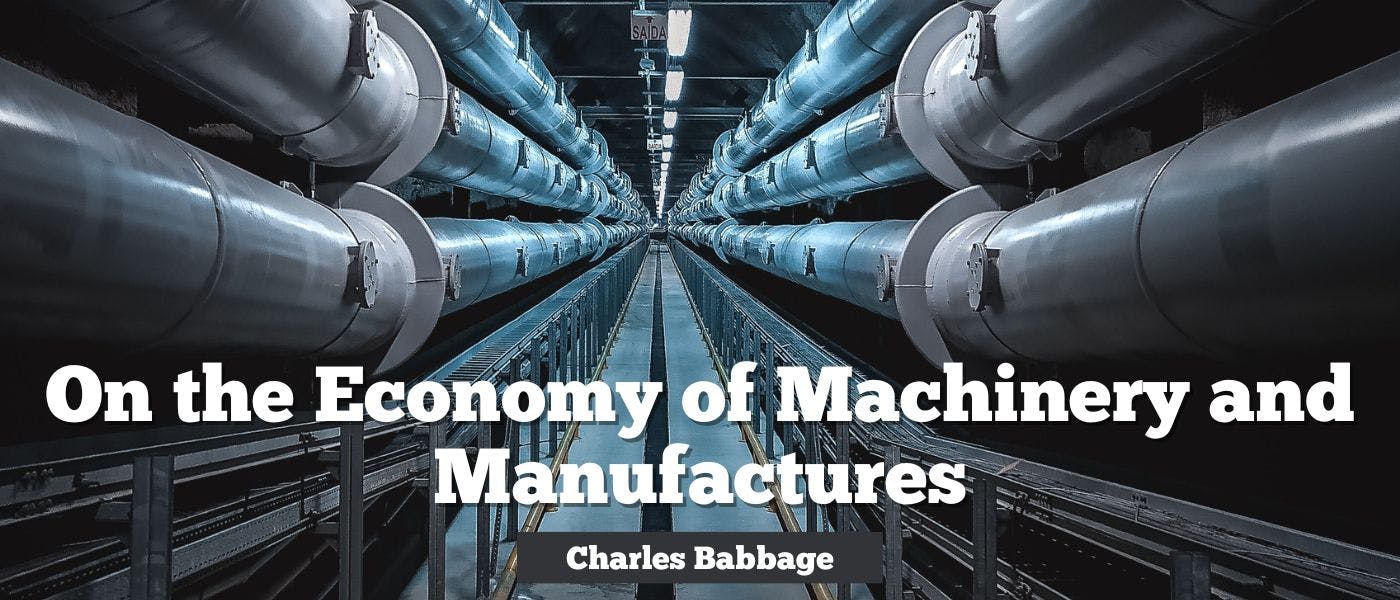On the Economy of Machinery and Manufactures by Charles Babbage, is part of the HackerNoon Books Series. You can jump to any chapter in this book here. On the Effect of Machinery in Reducing the Demand for Labour
Chapter 32. On the Effect of Machinery in Reducing the Demand for Labour
404. One of the objections most frequently urged against machinery is, that it has a tendency to supersede much of the hand labour which was previously employed; and in fact unless a machine diminished the labour necessary to make an article, it could never come into use. But if it have that effect, its owner, in order to extend the sale of his produce, will be obliged to undersell his competitors; this will induce them also to introduce the new machine, and the effect of this competition will soon cause the article to fall, until the profits on capital, under the new system, shall be reduced to the same rate as under the old. Although, therefore, the use of machinery has at first a tendency to throw labour out of employment, yet the increased demand consequent upon the reduced price, almost immediately absorbs a considerable portion of that labour, and perhaps, in some cases, the whole of what would otherwise have been displaced.
That the effect of a new machine is to diminish the labour required for the production of the same quantity of manufactured commodities may be clearly perceived, by imagining a society, in which occupations are not divided, each man himself manufacturing all the articles he consumes. Supposing each individual to labour during ten hours daily, one of which is devoted to making shoes, it is evident that if any tool or machine be introduced, by the use of which his shoes can be made in half the usual time, then each member of the community will enjoy the same comforts as before by only nine and one-half hours' labour.
405. If, therefore, we wish to prove that the total quantity of labour is not diminished by the introduction of machines, we must have recourse to some other principle of our nature. But the same motive which urges a man to activity will become additionally powerful, when he finds his comforts procured with diminished labour; and in such circumstances, it is probable, that many would employ the time thus redeemed in contriving new tools for other branches of their occupations. He who has habitually worked ten hours a day, will employ the half hour saved by the new machine in gratifying some other want; and as each new machine adds to these gratifications, new luxuries will open to his view, which continued enjoyment will as surely render necessary to his happiness.
406. In countries where occupations are divided, and where the division of labour is practised, the ultimate consequence of improvements in machinery is almost invariably to cause a greater demand for labour. Frequently the new labour requires, at its commencement, a higher degree of skill than the old; and, unfortunately, the class of persons driven out of the old employment are not always qualified for the new one; so that a certain interval must elapse before the whole of their labour is wanted. This, for a time, produces considerable suffering amongst the working classes; and it is of great importance for their happiness that they should be aware of these effects, and be enabled to foresee them at an early period, in order to diminish, as much as possible, the injury resulting from them.
407. One very important enquiry which this subject presents is the question whether it is more for the interest of the working classes, that improved machinery should be so perfect as to defy the competition of hand labour; and that they should thus be at once driven out of the trade by it; or be gradually forced to quit it by the slow and successive advances of the machine? The suffering which arises from a quick transition is undoubtedly more intense; but it is also much less permanent than that which results from the slower process: and if the competition is perceived to be perfectly hopeless, the workman will at once set himself to learn a new department of his art. On the other hand, although new machinery causes an increased demand for skill in those who make and repair it, and in those who first superintend its use; yet there are other cases in which it enables children and inferior workmen to execute work that previously required greater skill. In such circumstances, even though the increased demand for the article, produced by its diminished price, should speedily give occupation to all who were before employed, yet the very diminution of the skill required, would open a wider field of competition amongst the working classes themselves.
That machines do not, even at their first introduction, invariably throw human labour out of employment, must be admitted; and it has been maintained, by persons very competent to form an opinion on the subject, that they never produce that effect. The solution of this question depends on facts, which, unfortunately, have not yet been collected: and the circumstance of our not possessing the data necessary for the full examination of so important a subject, supplies an additional reason for impressing, upon the minds of all who are interested in such enquiries, the importance of procuring accurate registries, at various times, of the number of persons employed in particular branches of manufacture, of the number of machines used by them. and of the wages they receive.
408. In relation to the enquiry just mentioned, I shall offer some remarks upon the facts within my knowledge; and only regret that those which I can support by numerical statement are so few. When the crushing mill, used in Cornwall and other mining countries, superseded the labour of a great number of young women, who worked very hard in breaking ores with flat hammers, no distress followed. The reason of this appears to have been, that the proprietors of the mines, having one portion of their capital released by the superior cheapness of the process executed by the mills, found it their interest to apply more labour to other operations. The women, disengaged from mere drudgery, were thus profitably employed in dressing the ores, a work which required skill and judgement in the selection.
409. The increased production arising from alterations in the machinery, or from improved modes of using it, appears from the following table. A machine called in the cotton manufacture a 'stretcher', worked by one man, produced as follows:
Year; Pounds of cotton spun; Roving wages per score; Rate of
earning per week
s. d. s. d.
1810 400 1 31/2 25 10(1*) 1811 600 0 10 25 0 1813 850 0 9 31 101/2 1823 1000 0 71/2 31 3
The same man working at another stretcher, the roving a little finer, produced,
1823 900 0 71/2 28 11/2 1825 1000 0 7 27 6 1827 1200 0 6 30 0 1832 1200 0 6 30 0
In this instance, production has gradually increased until, at the end of twenty-two years, three times as much work is done as at the commencement, although the manual labour employed remains the same. The weekly earnings of the workmen have not fluctuated very much, and appear, on the whole, to have advanced: but it would be imprudent to push too far reasonings founded upon a single instance.
410. The produce of 480 spindles of 'mule yarn spinning', at different periods, was as follows:
Year; Hanks about 40 to the pound; Wages per thousand (s. d.)
1806; 6668; 9 2 1823; 8000; 6 3 1832; 10,000; 3 8
411. The subjoined view of the state of weaving by hand- and by power-looms, at Stockport, in the years 1822 and 1832, is taken from an enumeration of the machines contained in 65 factories, and was collected for the purpose of being given in evidence before a Committee of the House of Commons.
In 1822 In 1832
Hand-loom weavers 2800 800 2000 decrease
Persons using power-looms 657 3059 2402 increase
Persons to dress the warp 98 388 290 increase
Total persons employed 3555 4247 692 increase
Power-looms 1970 9177 8207 increase
During this period, the number of hand-looms in employment has diminished to less than one-third, whilst that of power-looms has increased to more than five times its former amount. The total number of workmen has increased about one-third; but the amount of manufactured goods (supposing each power-loom to do only the work of three hand-looms) is three and a half times as large as it was before.
412. In considering this increase of employment, it must be admitted, that the two thousand persons thrown out of work are not exactly of the same class as those called into employment by the power-looms. A hand-weaver must possess bodily strength, which is not essential for a person attending a power-loom; consequently, women and young persons of both sexes, from fifteen to seventeen years of age, find employment in power-loom factories. This, however, would be a very limited view of the employment arising from the introduction of power-looms: the skill called into action in building the new factories, in constructing the new machinery, in making the steam-engines to drive it, and in devising improvements in the structure of the looms, as well as in regulating the economy of the establishment, is of a much higher order than that which it had assisted in superseding; and if we possessed any means of measuring this, it would probably be found larger in amount. Nor, in this view of the subject, must we omit the fact, that although hand-looms would have increased in number if those moved by steam had not been invented, yet it is the cheapness of the article manufactured by power-looms which has caused this great extension of their employment, and that by diminishing the price of one article of commerce, we always call into additional activity the energy of those who produce others. It appears that the number of hand-looms in use in England and Scotland in 1830, was about 240,000; nearly the same number existed in the year 1820: whereas the number of power-looms which, in 1830, was 55,000, had, in 1820, been 14,000. When it is considered that each of these powerlooms did as much work as three worked by hand, the increased producing power was equal to that of 123,000 hand-looms. During the whole of this period the wages and employment of hand-loom weavers have been very precarious.
413. Increased intelligence amongst the working classes, may enable them to foresee some of those improvements which are likely for a time to affect the value of their labour; and the assistance of savings banks and friendly societies, (the advantages of which can never be too frequently, or too strongly, pressed upon their attention), may be of some avail in remedying the evil: but it may be useful also to suggest to them, that a diversity of employments amongst the members of one family will tend, in some measure, to mitigate the privations which arise from fluctuation in the value of labour.
NOTES:
1. In 1810, the workman's wages were guaranteed not to be less than 26s.
About HackerNoon Book Series: We bring you the most important technical, scientific, and insightful public domain books.
This book is part of the public domain. Charles Babbage (2003). On the Economy of Machinery and Manufactures. Urbana, Illinois: Project Gutenberg. Retrieved https://www.gutenberg.org/cache/epub/4238/pg4238.html
This eBook is for the use of anyone anywhere at no cost and with almost no restrictions whatsoever. You may copy it, give it away or re-use it under the terms of the Project Gutenberg License included with this eBook or online at www.gutenberg.org, located at https://www.gutenberg.org/policy/license.html.

